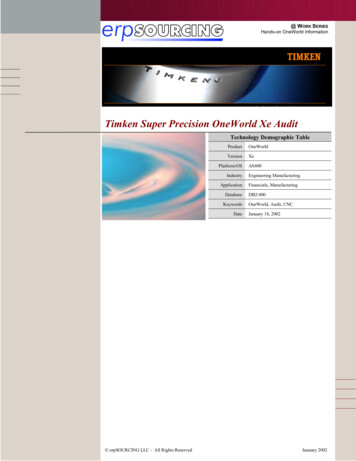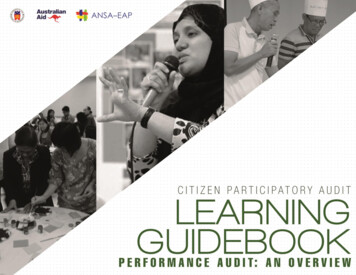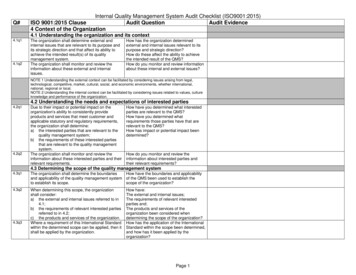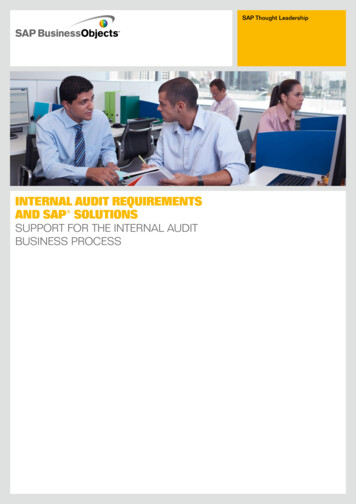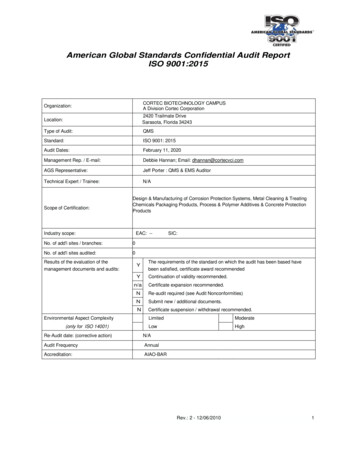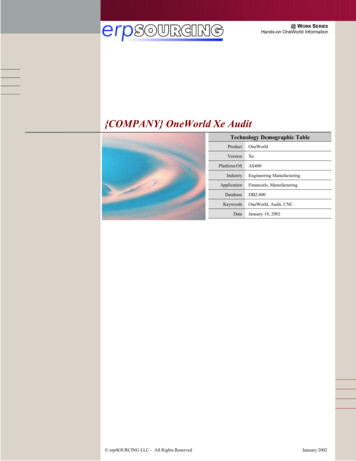
Transcription
@ WORK SERIESHands-on OneWorld Information{COMPANY} OneWorld Xe AuditTechnology Demographic plicationDatabaseKeywordsDate erpSOURCING LLC - All Rights ReservedAS400Engineering ManufacturingFinancials, ManufacturingDB2/400OneWorld, Audit, CNCJanuary 18, 2002January 2002
-Timken Super Precision OneWorld Xe AuditDisclaimerAll information contained in this document should be treated as hypothetical. ErpSOURCINGprovides advice and informative views that are independent of JD Edwards. All views andinformation contained herein may either be countered by JD Edwards documentation or maynot apply to other customers or project plans. All information is therefore provided as arecommendation – and no information can be treated as a guarantee to project success nor as aguarantee against failure. Any project information and/or plan is viewed as information sharedsolely between erpSOURCING LLC and The customer ({COMPANY}) – and should only beshared with members outside the companies only with the explicit permission oferpSOURCING LLC. All documentation contained herein is property of erpSOURCING LLCand is protected by Colorado laws.None of the entries in this document are in any way a replacement for any JDEdwardsOneWorld Xe documentation – and should be viewed as a complement to any existingdocumentation.Overview{COMPANY} is classed as a “medium” sized implementation of OneWorld. The project planincludes deployment to no more than 150 concurrent users with the current technicalarchitecture – and the transaction loads are viewed to be well within recommended JDEdwards OneWorld tested recommendations.This document will attempt to audit and document the current JD Edwards OneWorld Xeimplementation – and will make recommendations based on the findings. The audit is strictlylimited to subjects related to the Technical CNC architecture – and will only lightly touch theapplication and modules that are being implemented.It is hoped that through these recommendations, {COMPANY} will be able to comfortablymove forward in their deployment of JD Edwards OneWorld with minimal delays arising dueto Technical issues. Recommendations will also cover a future plan of how OneWorld Xe is tocontinue to be upgraded and provides information for any new member of the project that mustperform CNC duties.RecommendationsThroughout this document, a number of different types of recommendation will be made.These are graded based on the level of impact : GREEN - Praises – these will highlight areas of outstanding configuration. ORANGE – Recommendations – these will highlight opinions and recommendationsfor general cleanup or for future scalability and performance. RED – Issues – these require to be changed at the earliest opportunity. Often, thesewill also contain outlined information how how to resolve the issue. BLUE – Information – these are designed for education and to answer questions thatthe reader may have concerning certain settings. erpSOURCING LLC - All Rights ReservedPage 2
-Timken Super Precision OneWorld Xe AuditVersion of OneWorldFor the purpose of this document, it isimportant to note that {COMPANY} isrunning OneWorld B7333XU2SP17.1E1(Xe Service Pack 17.1 E1 – Update 2). GREEN – Up to date software This is a highly current version of JD Edwards OneWorld. The service pack revision is extremely high and upto-date. BLUE – Information concerning Updates and new versions Note that Update 3 and 4 have arrived and are now readily available. JD Edwards are also releasing XeVersion 2 at some point in 2002. It is also important that a lot of new functionality is to be scheduled forrelease in “B9” which is due out sometime over the next 2 years. With all of these versions, it is important to understand exactly what is required to run the business, andexactly what will work as far as upgrade paths. During the Prototype stage – it is important to try to keep asup to date with JD Edwards recommended software as much as possible. As more and more developmentcontinues (see Development Cycle section) – then the larger impact an ESU or an Update will be. Eventually,an ESU or Update will be a critical impact on the system, requiring dedicated development and testingresources, once the OneWorld product is live. In our recommendations, we state that it is important to keep as up to date as possible UNTIL go live. At thatpoint – if bugs arise that JD Edwards development state require ESU’s to fix, then those ESU’s can be appliedto Pristine and tested through the development cycle to ensure as little impact as possible on Production. JD Edwards requires updates for all customers ONLY to simplify their support of the product. If allcustomers are on the same exact version, then they can test the same issue inside the OneWorld support desk.Having various different releases complicates support for JD Edwards. On the other hand, having an ESUapplied to a critical application – such as Sales Order Entry – which fixes a bug in a system that{COMPANY} has not even purchased – will lead to lengthy development and testing issues. Service packs, on the other hand, are relatively easy to implement. They are easy to roll back and affecteverybody across the board since they directly update Foundation code. It is recommended that duringPrototype, Service Packs are “liberally applied” and often updated. However, when go-live occurs, it isimportant to let other JD Edwards OneWorld customers “test” the service pack prior to implementation – andusually the recommendation is that the customer stay approximately 3 months behind the latest service packrevision. If issues arise (a good resource is http://www.jdelist.com for information on issues) – then thecustomer can jump a service pack whenever they feel comfortable. Remember that certain Service Packs mayrequire ESU’s – especially against the Planner Environment. Lastly, remember that ESU’s cost time to implement – and that this time will impact the cost ROI of theOneWorld project. ORANGE – One-offs It is important that at this revision (SP17.1) the JD Edwards Knowledge Garden is constantly monitored for oneoffs, and that these one-offs are applies as early as possible. Currently, the list of one-offs include the following:SP Name Description SP17.1 Service Pack 17.1 for B73.3.1, B73.3.1-Xe Release Status Build DateAvailable 11/15/01 SP17.1 E2 OneOff SP17.1 E2 B73.3.1-Xe Available 1/17/02 SP17.1 UDB OneOff SP17.1 UDB B73.3.1-Xe Available 11/9/01 RED – One Off SP17.1 E2 has not been implemented Service Pack SP17.1 E1 was implemented – but unfortunately there are issues with this One-Off. It seems as ifE2 has now just been release (1/17/02) – and requires to be implemented to ensure that SAR’s are installed thataffect the current environment. Note that additional One-Offs may be released in quick succession. It istherefore imperative that testing occur on every OneWorld function to ensure that this Service Pack will notcreate an issue. erpSOURCING LLC - All Rights ReservedPage 3
-Timken Super Precision OneWorld Xe AuditMIS OrganizationThe OneWorld team is made up of both internal {COMPANY} resources, as well as outsideresources from Westlake Consulting and independent consultants.It seems as if the majority of the internal users have been trained technically with OneWorld –since the administration and configuration of the OneWorld system is working extremely well,however – there have been issues with new contract and outside assistance in the use of newXe functionality such as OMW. It is envisaged that these anomalies are not mission critical.Westlake ConsultingRobyn Bctvs – Projvct LvcdPczl Bozdrvcz – SclvsBvth Hclvonfk – FfncncvTom McCormfck – McnzfcctzrfngHzgh Portvr – Pzrchcsfng/McnzfcctzrfngProject OneWorld Team – MPBGxry Tkchtvrmxn – Prkjvct LvxdDvbbwv Bxwlvy – Sxlvs & DwstrwbutwknJxck Hkrnbvck – PurchxswngMwkv Kxvvnxgh – Vngwnvvrwng/CknfwgurxtkrPxul Wwlskn – MxnufxcturwngPvtvr Zxvkrktny – FwnxncvJudy Lvssxrd – Tvchnwcxl erpSOURCING LLC - All Rights ReservedPage 4
-Timken Super Precision OneWorld Xe AuditNetwork ArchitectureMPBHNT02Deployment Server147.185.86.7AS400/INS CardC: 2Gb/745MbD: 1Gb/837MbE: 62Gb/15.2GbF: 2Gb/809MbMPBHTS03Citrix Server147.185.85.6PY7333 & PD7333C: 4Gb/2.7GbD: 12.9Gb/5.2GbMPBHTS01Citrix Server147.185.85.5PY7333 & PD7333C: 4Gb/2.33GbD: 12.9Gb/6.2Gb100mb EthernetToken RingMPBHTS04Citrix Server147.185.85.7PY7333 & PD7333C: 4Gb/2.7GbD: 12.9Gb/5.2GbMPBHTS05Citrix Server147.185.85.14PY7333 & PD7333C: 4Gb/2.7GbD: 12.9Gb/5.2GbMPBHTS06Citrix Server147.185.85.15PY7333 & PD7333C: 4Gb/2.7GbD: 12.9Gb/5.2GbMPBHERP1Enterprise Server147.185.84.5CorporateThin clients/DevelopersMPBHTS07Citrix Server147.185.85.9PY7333 & PD7333C: 4Gb/2.7GbD: 12.9Gb/5.2GbThe {COMPANY} network is relatively simple, but contains a number of issues that need tobe resolved.Currently, the AS400 has an INS card (Single 700MHz processor with 512Mb memory) and a“carved out” disk partition to provide enough space to act as the primary deployment server. Itis envisaged that in the near future, to provide additional scalability and for performancereasons, this INS card is to be replaced with a new external IBM X-Series Dual Processormachine. This will increase the speed of the client package builds. ORANGE – Change the Enterprise Server connectivity type – The Enterprise Serverconnectivity is at an issue, since the Terminal Servers have to cross a TokenRing/Ethernet Router. After discussions with the CNC team, it is apparent that anEthernet solution is steadily replacing the Token Ring across {COMPANY}. Soon, thiswill allow the Enterprise Server is to be connected to a fast Ethernet Switch via Fiberconnectivity. BLUE – Why change the LAN configuration ? – By changing the LAN Architectureto a single, more up to date configuration, this will increase the speed of any OneWorldClient-based (interactive) operation that is network intensive. This should occur prior tothe Deployment Server replacement being implemented to ensure that the packagebuilds do not affect production. GREEN – Using a Class B address – Although {COMPANY} uses a Class B PublicTCP/IP network allocation ( 147.185.0.0 – 147.185.255.255), the majority of IPAddresses are invisible from the Internet. erpSOURCING LLC - All Rights ReservedPage 5
-Timken Super Precision OneWorld Xe AuditClient configurationsThere are 25 recorded distinct OneWorld Clients that have accessed the OneWorld system.There are also 6 Microsoft Terminal Servers running Citrix Metaframe 1.8. A standardOneWorld Development Workstation is a single processor Dell with 256Mb RAM.A standard OneWorld Citrix Terminal Server is a Dual 1Ghz PIII with 2Gb RAM and a RAID5 array of 4 x 9.1Gb Drives. A recommendation is to ensure that the Citrix servers have10,000RPM drives in them in the future to increase application load performance. Based onthe specifications of the Terminal Servers, it should be possible to run as many as 240concurrent users across these 6 machines.F9650System – B7333Machine NameDescriptionLast FullPrimary User W646Primary Enterprise Svr- KeeneMPBHNT01 - JDEPrimary Deployment Server-KeenMPBHTS01 - MANLEYTMPBHTS03 - MANLEYTMPBHTS04 - MANLEYTMPBHTS05 - MANLEYTMPBHTS06 - MANLEYTMPBHTS07 - MANLEYTMPBW022 - LESSARDJMPBW026 – FLAGLERMPBW031 – BAILEYDEMPBW037 – MANLEYTMPBW391 - HOLLANROMPBW415 - Steve FernandezMPBW438 - LESSARDJMPBW470 – MANLEYTMPBW485 - JOBINEMPBW506 - HALLNANCMPBW533 - ZAVAROTPMPBW535 - GODDUJMPBW548 - LESSARDJMPBW549 – MILLIROMMPBW551 - THOMASJAMPBW553 - MEADEKENMPBW563 – FLAGLERMPBW570 – WILSONPMPBW571 - KAVENAGMMPBW574 - Package Build MachinMPBW575 - MPBJDE03MPBW576 - MPBJDE02MPBW620 - ShippingMPBW626 - LESSARDJMPBW646 - ast AJD7333FE00PY7333FE32PDSP17 1PY7333FE32PY7333FE32PY7333FE32PY7333FE32SP17 1 17 1JD11697SP17 1 48WK0423ATRMJD11709JD11709PD7333FE02JD11709 ORANGE – cleanup of the Machine Identification Table In the SYS7333.F9650, there are a number of duplicated rows – specifically for “MPBHNT01”,“MPBHTS04”, “MPBHTS05”, “MPBHTS06”. The redundant rows (identified by empty values inMMPKGNM and MMPKGUPDNM) should be cleaned out. It also seems as if there are someworkstations here that have not been cleared out from the table once dropped from the OneWorld network(ie – reconfigured or reformatted). BLUE – Why are there missing Last package values ? Sometimes this table is not correctly updated if the last update was performed outside of a configured“push” through package deployments (P9631). Workstations often are updated directly – through runningof SETUP.EXE. erpSOURCING LLC - All Rights ReservedPage 6
-Timken Super Precision OneWorld Xe AuditEnterprise Server{COMPANY} have a single Enterprise Server. They do not need to move to a three-tierenvironment with the current load. However, there may be some tuning opportunities toensure that the Enterprise Server is not overly utilized.Configuration of MPBHERP1The heart of the {COMPANY} Enterprise system is the AS400 – MPBHERP1. This is a 4way 9406 Model 830 with 245D processors. There is 8192 Mb Main Storage (RAM) made upof 16x128Mb cards and 24 x 256Mb cards.There are 38x9Gb drives in the RAID array with varying amounts of space in the DASD.Currently, there is 277012 Mb (approximately 277 Gb) of DASD available to the system, andcurrently the RAID is 77.8% utilized (there is 61Gb available). ORANGE – High utilization of DASD storage Currently, given the fact that neither Distribution nor Manufacturing are live and havebeen rolled out, {COMPANY} are using a large amount of storage which needs to beinvestigated for the future. With the removal of the INS Deployment Server (and thereclaimation of 65Gb of storage) the total amount of storage prior to go-live is 120Gb. Looking at the size of the F0911, which is currently at 71Mb in Production – thiscould conceivably grow substantially as Distribution and Manufacturing processesstart writing historical information. It is therefore suggested that {COMPANY}investigate into the cost of increasing the amount of Drive space available to theAS400 – and a project plan for when this increase would occur.Standard Tuning ParametersThere is a document available – “Tuning Recommendations for the AS/400” from JD EdwardsWorldwide Advanced Technology services. This document is dated December, 1998 – and istherefore currently older than the current version of OS that {COMPANY} are running – butthere are some parameters that {COMPANY} may need to investigate with IBM in tuning.AS/400 TCP/IP Tuning GREEN - TCP/IP Maximum Transmission Unit is correctly tuned Currently, given the fact that neither Distribution nor Manufacturing 1. Set TCP/IProuting maximum transmission unit (MTU) to *IFCDisplay TCP/IP RouteRoute destination . . . . .Subnet mask . . . . . . . .Type of service . . . . . .Next hop . . . . . . . . . .Preferred binding interfaceMaximum transmission unit .Duplicate route priority . .Route metric . . . . . . . .Route redistribution . . . . erpSOURCING LLC - All Rights RMAL147.185.84.1*NONE*IFC51*NOPage 7
-Timken Super Precision OneWorld Xe Audit ORANGE – Could not validate TCP/IP Buffer Size Current values for CHGTCPA could not be retrieved since authority was not granted.The suggested recommendation is as follows :Change TCP/IP Attributes (CHGTCPA)Type choices, press Enter.TCP keep alive . . . . . . . . . . . . .120TCP urgent pointer . . . . . . . . .*BSDTCP receive buffer size . . . . . .65536TCP send buffer size. . . . . . . . .65536UDP checksum. . . . . . . . . . . . .*YESIP datagram forwarding . . . . . .*NOIP reassembly time-out . . . . . . .120IP time to live . . . . . . . . . . . . .64ARP cache timeout . . . . . . . . .5Log protocol errors . . . . . . . . .*NO1-40320, *SAME, *DFT*SAME, *BSD, *RFC512-8388608, *SAME, *DFT512-8388608, *SAME, *DFT*SAME, *YES, *NO*SAME, *YES, *NO60-120, *SAME, *DFT1-255, *SAME, *DFT1-1440, *SAME, *DFT*SAME, *YES, *NOAS/400 Subsystem Tuning GREEN – Subsystem is tuned Put memory in *BASE and allow OS/400 to manage memory allocation Change QPWFSERVER class to purge *NOChange Class (CHGCLS)Type choices, press Enter.Class . . . . . . . . . .Library . . . . . . . .Run priority . . . . . . .Time slice . . . . . . . .Eligible for purge . . . .Default wait time . . . .Maximum CPU time . . . . .Maximum temporary storageMaximum threads . . . . .Text 'description' . . . . QPWFSERVERName.*LIBLName, *LIBL, *CURLIB.201-99, *SAME.3000Milliseconds, *SAME.*NO*SAME, *YES, *NO.30Seconds, *SAME, *NOMAX.*NOMAXMilliseconds, *SAME, *NOMAX.*NOMAXKilobytes, *SAME, *NOMAX.*NOMAX1-32767, *SAME, *NOMAX.'FILE SERVER JOB CLASS' ORANGE – Could not validate number of Prestart jobs for QZDASOINIT Current Increase the number of prestart jobs for programs QZDASOINITThis is an iterative type of change as more users or applications are added or removed– and, of course, the number of ODBC connections that may be required for eachuser.A symptom of not having enough prestart jobs is that either connections are slow inbeing made, or a connection attempt will fail, but when it is retried, it is successful.Note, if too many prestart jobs are waiting, the system will automatically end some ofthem. Also, as prestart jobs are used, additional ones will be initiated.As a starting point, OneWorld user applications typically use 3-8 ODBC connections.Each ODBC connection is connected to one QZDASOINIT programs. The programsQZSCSRVS and QZSOSIGN are used for making the connection. Therefore, theinitial value for QZDASOINIT could be set to be 5 times the number of expectedconcurrent connected users.Note, the current maximum value allowed is 1,000 via the screen interface. erpSOURCING LLC - All Rights ReservedPage 8
-Timken Super Precision OneWorld Xe Audit BLUE – To determine prestart job configuration To determine at any given time how many prestart jobs are available and have beenused enter the following command:DSPACTPJ QSERVER QIWS/QZDASOINITThe following information is an example of what will be displayedDisplay Active Prestart JobsPage15769SS1 V4R1M0 970829MAUI02/24/98 18:47:23Display Active Prestart JobsSubsystem . . . . . :QSERVERReset date . . . . . :02/20/98Program . . . . . . . : QZDASOINITReset time . . . . . :21:42:57Library . . . . . . : QIWSElapsed time . . . . :0093:04:26Prestart jobs:Current number . . . . . . . . . . . . . . . . . :1,456Average number . . . . . . . . . . . . . . . . :1108.4Peak number . . . . . . . . . . . . . . . . . . . :2,034Prestart jobs in use:Current number . . . . . . . . . . . . . . . . . :1,203Average number . . . . . . . . . . . . . . . . :153.6Peak number . . . . . . . . . . . . . . . . . . . :2,034Program start requests:Current number waiting . . . . . . . . . . . :0Average number waiting. . . . . . . . . . . :.0Peak number waiting . . . . . . . . . . . . . :1Average wait time . . . . . . . . . . . . . . . . :00:00:00.0Number accepted . . . . . . . . . . . . . . . . :13103Number rejected. . . . . . . . . . . . . . . . :0The important value to look at to determine what to set your system for is the Peaknumber in the Prestart jobs in use section.When changing the prestart job values, you must either restart the subsytem or end allof the prestart jobs and restart them (ENDPJ, STRPJ) command.To Adjust QZSOSIGN,QZSCSRVS prestart jobsIf the client PCs are NOT configured to bypass the signon check (see ODBC tuningsection), then the prestart jobs QZSOSIGN and QZSCSRVS initial values should alsobe adjusted similar to the way the job QZDASOINIT was adjusted. These two jobsrun in subsystem QSYSWRK and their status can be displayed by entering thefollowing commands.DSPACTPJ QSYSWRK QIWS/QZSOSIGNDSPACTPJ QSYSWRK QIWS/QZSCSRVSThe command to change the number of prestart jobs is CHGPJE. The following is anexample Screen display:Change Prestart Job Entry (CHGPJE)Subsystem description . . . . . .Library . . . . . . . . . . . .*LIBL, *CURLIBProgram . . . . . . . . . . . . .Library . . . . . . . . . . . .*LIBL, *CURLIBUser profile . . . . . . . . . . .Start jobs . . . . . . . . . . . .*YES, *NOInitial number of jobs . . . . . .Threshold . . . . . . . . . . . .*SAMEAdditional number of jobs . . .Maximum number of jobs . . . . erpSOURCING LLC - All Rights Reservedqserver. . . .Name*LIBLName,. . . . . .qzdasoinitqiwsNameName,. . . . . .*SAME*SAMEName, *SAME*SAME,. *SAME. . .1-1000, *SAME*SAME1-1000,*SAME*SAME0-999, *SAME1-1000, *SAME, *NOMAXPage 9
-Timken Super Precision OneWorld Xe AuditFor QZDASOINIT, the recommended value for the Threshold is 5, and for Additionalnumber of jobs 25.For QZSOSIGN,QZSCSRVS , the recommended value for the Threshold is 1, andfor Additional number of jobs 3.To see the current settings, use option 10 from command DSPSBSD QSERVER, thenoption 5, for program QIWS/QZDASOINIT.Display Active Prestart JobsSubsystem . . . . . :Program . . . . . . :Library . . . . . :S104X8VM01/21/02 13:44:45Reset date . . . . . :01/20/02Reset time . . . . . :06:38:54Elapsed time . . . . :0031:05:50QSERVERQZDASOINITQIWSPrestart jobs:Current number . . . . . . . . . . . . . . . . :Average number . . . . . . . . . . . . . . . . :Peak number . . . . . . . . . . . . . . . . . :250249.9250Prestart jobs inCurrent numberAverage numberPeak number .12425.3154use:. . . . . . . . . . . . . . . . :. . . . . . . . . . . . . . . . :. . . . . . . . . . . . . . . . :Program start requests:Current number waitingAverage number waitingPeak number waiting .Average wait time . .Number accepted . . .Number rejected . . .::::::0.0000:00:00.012380The Max Active job value may need to be increased for the pool in which the ODBCjobs are run. An indication of a need for this is if there is an increase in the number ofjobs in the INELIGIBLE status. Display this using the WRKSYSACT command.Press F11.The Max Active can be displayed and changed by the WRKSYSSTS andWRKSHRPOOL commands.Work with System Status01/21/02% CPU used . . .% DB capabilityElapsed time . .Jobs in system .% perm addresses% temp addresses.::::::3.2.000:00:014802.015.044Auxiliary storage:System ASP . . . . . .% system ASP used . .Total . . . . . . . .Current unprotect usedMaximum unprotect . .:::::S104X8VM13:49:45283.4 G78.0435283.4 G4803 M4961 MType changes (if allowed), press Enter.SystemPool1234PoolSize (M)558.237140.19411.6481.91ReservedSize (M)342.28.08.00.00MaxActive 3731595-----DB----Fault Pages.0.0.01.7.0.0.0.0---Non-DB--Fault Pages.0.031.431.43.54.4.0.0Refer to the chapter “Performance Tuning” in the “AS/400 Advanced Series WorkManagement” guide for more detail of the above commands. erpSOURCING LLC - All Rights ReservedPage 10
-Timken Super Precision OneWorld Xe AuditDatabase IndexesAS/400 supports both 3 byte and 4 byte indexes. For best performance the 4 byte index shouldbe used. Beginning with V4R1, the default is to use 4 byte indexes. However, customersmigrating from earlier releases and installations may still have some 3 byte indexes.To see if an index is 3 or 4 byte index, enter the command DSPFD lib/logicalfielname orDSPFD lib/*all to list all files in a library.The following entry shows a 3 byte indexAccess path size . . . . . . . . . . . . . : ACCPTHSIZ *MAX4GBThe 4 byte index value is *MAX1TB .The index can be changed to 4 byte by entering the command -- CHGLF and for the keywordACCPTHSIZ specify *MAX1TB . When an index type is changed (even if the same type), itwill be rebuilt.Additional database indexes may help to improve performance. These will depend on thecustomer and the applications they are using.The suggested method is to use the database monitor (command STRDBMON) to determinewhat may be appropriate change. Then run a test before and after the change to measure theaffect.NOTE: Any time a new index is created, the SQL packages should be deleted so that theywill be recreated the next time with updated access rules. To find out what SQL packagesexist, enter the command WRKOBJ *ALL/*ALL *SQLPKG.In addition, the system performance monitor tool (strpfrmon) should be used to monitor foroverall system performance. This will show items such as high I/O contentions, disk armresponse times, etc.Appendix 1 will cover Common Queries from SQL to understand DB Performance andwhether new logical files are required. ORANGE – Create custom indexes (logical files) All OneWorld customers use the OneWorld data model differently. It is highlyrecommended that as more users start being deployed with the Distribution andManufacturing modules, that additional logical files will require to be created basedon table-scans. Using the Common SQL Queries in the Appendix, it is possible toidentify these “full open” queries, and create additional logical files to compensate. Itis recommended that IBM should be contacted to help with these queries. erpSOURCING LLC - All Rights ReservedPage 11
-Timken Super Precision OneWorld Xe AuditJOURNALING{COMPANY} have journaling configured – under the [DB System Settings] section of theServer .INI are the following configured journal settings :DefaultDefaultDefaultDefaultJournal OW JRNLJournal LIBRARY OWJRNLJournal Receiver OW JRNL000Journal Receiver LIBRARY OWJRNLUsing the WRKJRNA command, and checking the current list of Journaled files, there are 301members of OW JRN3199. According to JD Edwards, ESU’s may prevent this from furtheroccurring, and support calls should be set up to end journaling.Display Journaled FilesJournal. . . . . . :OW JRNLLibrary. . . . . . :OWJRNLNumber of journaled files . . . . . . . . . . . . . . . . . . :Number of journaled members . . . . . . . . . . . . . . . . . 11 ORANGE – Further investigation of Journaling Journaling is a normal procedure of OneWorld – it is the method that the AS400utilizes to ensure Rollback and Commitment control. However, as per JD Edwardsliterature, it is indicated that these journals should be removed upon the end of certaintransactions. It is therefore recommended that IBM skills are used to identify thejournal files that currently exist and determine appropriate actions to be taken. erpSOURCING LLC - All Rights ReservedPage 12
-Timken Super Precision OneWorld Xe AuditDeployment ServerThe deployment server (MPBHNT02) is an INS card that is sharing DASD with the AS400.This INS card is relatively new – with a 700MHz processor. However, because of the numberof packages built together with the number of ESU’s being deployed, the Deployment Serveris limited by the amount of space that it can use for cost reasons. ORANGE – replace the INS card with an external Deployment Server Because of the cost of DASD for the AS400, and the dramatic difference in cost forIntel based RAID solutions, {COMPANY} has purchased a dual 1GHz machine with2Gb RAM. This will decrease package build times, and return 65Gb of storage backto the AS400. This will also allow {COMPANY} to purchase more space for theDeployment server, allowing them to store packages for longer periods of time. RED – Too many ports and services open After scanning all open ports on the INS card,it was realized that the deployment server wasalso running a Web server. It was disclosedthat an issue occurred recently with the Webservice – which would have affecteddevelopment. The deployment server shouldbe dedicated as a Windows Fileserver – andhave FTP running for deployment of ServicePacks to the AS400. The administrator shouldlook through to understand what processes are running on the terminal server – anddisable access through to the ports that are not required. RED – No file-level backup solution for the deployment server It is important to understand that the Deployment Server contains all source code forthe C objects. As such, all of the development check-in of the C objects should beviewed as important data that should have a file-level backup solution implemented.This will allow for the administrator to restore individual C files if required ratherthan as an image, which is the way the backups occur currently. GREEN – Package cleanups By using a better naming convention for their packages, {COMPANY} are able tonow delete older packages that are no longer required by instantly viewing thepackage directory. GREEN – Changed the group share for B7333 and install Anti Virus software JD Edwards by standard will implement a
Timken Super Precision OneWorld Xe Audit Version of OneWorld For the purpose of this document, it is important to note that {COMPANY} is running OneWorld B7333XU2SP17.1E1 (Xe Service Pack 17.1_E1 – Update 2). GREEN – Up to date software This is a highly current version of JD Edwards OneW
